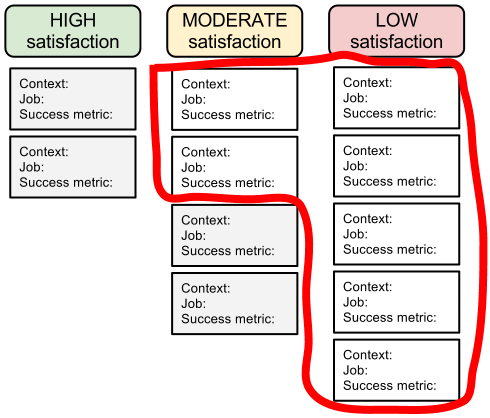On Quora, this question was asked:
Competition: How do you assess the value of a new product or service vs an incumbent’s?
Is there a starting set of criteria? eg. price, quantity provided, ease of use, breadth and so on. I’m thinking specifically of a product to supply financial news and information and prices.
What struck me about this question is that it has the entrepreneur’s optimism in it, while also running into the classic issue of running into entrenched players in the market (e.g. Bloomberg, Reuters). Entrenched players can be quite hard to displace. Not impossible of course, as we’ve seen with RIM’s one-dominant Blackberry.
I put together an answer that combines two concepts. It’s re-published below.
———————-
Focus on two areas to distinguish yourself from the competition:
- Jobs to be done
- 9x-improvement ideas
JOBS TO BE DONE
Start from the customers’ perspective. Always. In this case, get a handle on their Jobs-To-Be-Done. What are they hiring incumbent providers for? How are they using the financial information?
Given you’re looking at a startup in this field, I’m sure you have a good initial sense of what customers are doing. But I’d wager it’s incomplete. I work in the innovation management software realm, but I know I have incomplete knowledge about the jobs-to-be-done.
By knowing three things, you will be a long way toward identifying the competitive opportunities for your idea:
- The jobs-to-be-done
- The level of satisfaction with each
- The ranked importance of each
Next, I want to borrow a phrase from Jack London, “You can’t wait to know the jobs-to-be-done. You have to go after them with a club.” This means engaging prospects. There are some methodologies out there, such as Steve Blank’s The Four Steps to the Epiphany (2005 Book).
One thing I’d stress is that in soliciting the jobs-to-be-done, I’d stress three elements that should be known:
- Context: “When I…”
- Job: “I want to…”
- Success metric: “Decreased…”
I recently wrote up an approach to doing this, you can see it here:
Applying jobs-to-be-done to product and service design by Hutch Carpenter on Jobs-to-be-Done
An important result of that process is the generation of an opportunity map:
See where the highest priority, lowest satisfaction jobs-to-be-done are. Then…
9X-IMPROVEMENT IDEAS
OK, after talking with different prospects in your target market, you’ve got a good sense of what they’re trying to get done. You know where they feel current solutions are falling short, and how important the various jobs are.
And you know what they value in an outcome (success metric).
Here’s the tricky part of innovation. You need to displace the incumbents. Which is not easy. MIT researcher Andrew McAfee has a great post on the subject of displacing an incumbent: The 9X Email Problem
In it, he highlights research by a colleague regarding customers’ behavior when it comes to replacing an existing product/service with a new one. The gist of it is:
- People tend to underweight the prospective benefits of a technology by a factor of 3
- People tend to overweight the value of whatever it is they are being asked to give up by a factor of 3
Together, you get the need to improve on the current situation by 9x.
The good news is that the success metrics described by prospective customers in the job-to-be-done phase point to where a 9x improvement could potentially be designed.
Certainly, though, this is the art of innovation. How well does an idea deliver on improving those success metrics?
I’m @bhc3 on Twitter.




